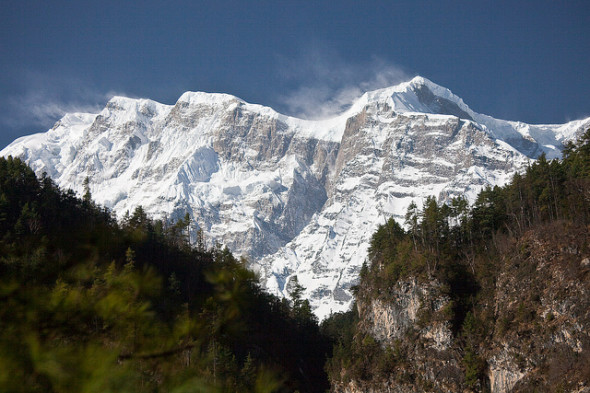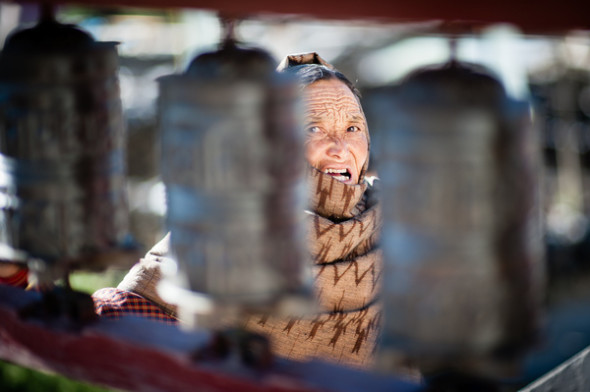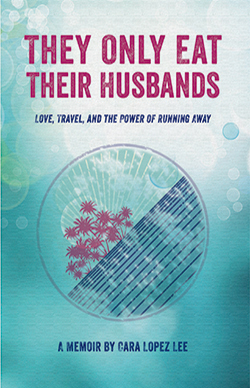by Cara Lopez Lee
from They Only Eat Their Husbands
Chame, Annapurna Circuit, Nepal
Was it only four days ago that I told myself all I had to do was get up each day and start walking? Beware the simple idea. Today’s leg was a long and difficult haul, and the realization that it’s only going to get harder the higher I go is like that recurring nightmare: the one where I find myself at school taking an exam for which I’ve never studied. Dharapani sits at about 1890 meters, Chame at about 2680. That’s an elevation gain of 800 meters (2600 feet) in five hours of walking. But it is, still, a simple idea: just . . . keep . . . walking.
We each fell into our own rhythm, and once again I found myself walking alone for most of the day. With no one else to distract me, each moment stood out in relief, the way I’ve heard moments do when you’re on acid—or about to die.
Alone. If you say a word often enough it empties and expands, empties and expands with meaning until it is no longer one thing, but all things. Alone no longer means joy or pain, love or loss, good or bad. It is only the journey I walk through. Alone is inevitable, and if there were ever a place for inevitability it would be the Himalayas. These mountains know what it is to be beyond loneliness, to simply sift the sun and snow for evidence of time and signs of life.
In Bagarchhap, I bought a small loaf of bread from a tiny bakery. A handful of children began following me, their eyes keeping time with the hard, dark little loaf swinging from my hand. I gave them each a piece, and their grins made the remaining heel of bread more enjoyable, although no less tough and chewy.
As I pushed on to Danaque, I heard bells jingling and was flabbergasted to see two men on horseback appear out of nowhere, bearing down on me at a gallop. I’ve become used to goats, cows, and pack animals, but this was new. It was the first sign that I was truly moving high up into the Himalayas and the villages of Nepal’s ethnic Tibetans.

In Danaque, I passed a whitewashed stone Mani Wall in the middle of the path, lined with a row of metal prayer wheels on either side. In a Mani Wall, each cylindrical wheel is inscribed with the Tibetan Buddhist mantra, “Om Mani Padme Hum,” and each wheel is stuffed with paper scrolls inscribed with the same mantra. An old woman was circling the wall counterclockwise, spinning the wheels—passing her hand along them the way a child might pass her hand along a chain link fence to set the metal vibrating—sending hundreds of mantras spinning to the heavens. I had the strange impression she had been walking around that wall, spinning those wheels, since the beginning of time, and would still be circling there at the end, when the universe stops circling and collapses inward on itself.
Leaving the old devotee to her loop, I continued moving forward to Chame, to meet the moment I’ve been waiting for: my first glimpse of Annapurna II, a true behemoth of the Annapurna Range. How do you describe the way your heart feels when you first fall in love? The way your body feels when you have your first orgasm? The way your mind feels when it first understands that everyone and everything will die, and in the next moment grasps the pure dumb miraculous luck of being alive? It is no wonder that great masters have wandered into the mountains and found enlightenment. Here enlightenment is not only something within, it is something external—so for even the most foolish among us there must be hope to find it.
As evening came, I spotted fresh snow falling on the distant peak of Annapurna II (8000 meters, or 26,000 feet) and the closer Lamjung Himal (6900 meters, or 22,700 feet). With the first sight of snow, came the first night of bone-aching cold.
Before dinner, I showered under a slender strand of lukewarm water so spare it only warmed one body part at a time, leaving the rest of my body a map of gooseflesh in the rapidly cooling high-altitude air. I made the mistake of washing my hair. It refused to dry and I shivered through dinner, even though I wrapped in several layers of clothing and pulled a wool cap over my wet head. Every few minutes, I left the dining area to stand by the kitchen woodstove with my cap off, trying in vain to dry my hair and warm up.
Several porters sat around the stove and we swapped pleasantries. Alan, a dark, compact porter with a wide, white grin, taught me several Nepali phrases, including the common greeting, “Kosta cha?” (How’s it going?), and the standard reply, “Ramro cha!” (It’s going great!).
After dinner, Nat philosophized about the spirituality and simplicity of Nepal’s mountain cultures. “The people who live in these mountains don’t stress over all the crap that drives the rest of us mad: getting ahead, buying a better house or car, working more to get more. They don’t concern themselves about acquiring things or attaining wealth the way Westerners do. As long as they have enough food to eat and a home to sleep in, they’re happy.”
Zack’s response was, “Yeah? Well if they’re so satisfied with what they have, why do their kids keep asking for my fucking pens?”
Seems to me we’re climbing to a place where both happiness and madness are beside the point.








